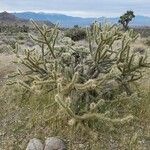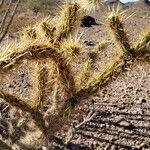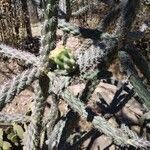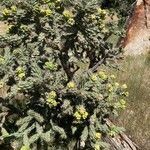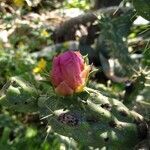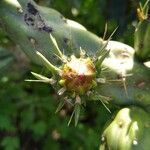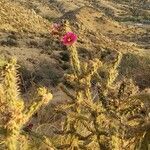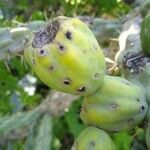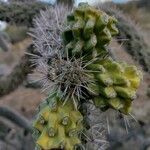Trees, with short trunks, or large shrubs, widely branching, (1-)1.5-2.5(-5) m. Stem segments firmly attached, whorled or subwhorled, gray-green, cylindric to weakly clavate, 10-40 × 1.5-4 cm; tubercles very prominent, widely spaced, (1.5-)2-5 cm; areoles elliptic, 5-8 × 3-4 mm; wool yellow to tan, aging gray to black. Spines (5-)8-15(-30) per areole or spineless to nearly spineless, usually at most areoles, not obscuring stems, spreading, straight or slightly curved, silver to yellow to usually ± red or tan to brown, stout, terete or sometimes flattened basally, 8-30(-40) mm subequal; sheaths silver to yellow to usually tan to dirty white, yellow tipped. Glochids in dense adaxial tuft, pale yellow, 0.5-3 mm. Flowers: inner tepals dark pink to magenta to red-magenta, obovate, apiculate, 15-35 mm; filaments green basally to pink to magenta distally; anthers yellow; style light green basally or pink to red-magenta apically; stigma lobes green or cream. Fruits not proliferating, yellow, obovoid, 24-45 × 20-40 mm, fleshy, tuberculate, spineless; areoles 18-30; tubercles nearly equal in length or longer in proximal portion of fruit, prominent (occasionally smooth at maturity); umbilicus 7-14 mm deep. Seeds yellow-tan, subcircular to angled, warped, 2.5-4 mm diam., sides smooth to slightly lumpy; girdle usually narrow, not protruding.
Plants c. 60-80 cm tall, forming much-branched compact bushes; the many short curved branches massed in upper part of plant, fairly equal in size. Joints cylindrical, tuberculate, c. 4-5 cm in diam., densely covered with radiating spines (up to 20) from each raised areole, almost hiding the stems; spines c. 25-40 mm long, covered with whitish sheaths. Flowers c. 4 cm long, rarely developed; hypanthium narrowly ovoid, the tubercles tipped with some minute acicular spines and claw-like leaf rudiments. Perianth segments with the inner petaloid, c. 10(-15) mm long, oblong, obtuse, wine-red, patent to recurved with age. Stamens and style shortly exserted, wine red. Fruits often proliferous, usually sterile, obtusely obovoid to globose, c. 3 cm long, swollen, nearly smooth.
Erect, branched, spreading shrubs often arborescent with age, up to 3 m high. Joints cylindrical, up to 40 cm long, 2-3 cm in diam., dark green with the raised prominent tubercles capped by areoles bearing 8-30 stellately arranged spines, these variable in length, up to 3 cm long, brown, minutely barbed and at first covered with a white papery sheath. Leaves subulate, 1-2 cm, early deciduous. Flowers 4-6 cm long with the hypanthium forming an abbreviated apical joint; petaloid segments red, rotate; stamens and style purple. Fruit obovoid, up to 5 cm long, yellow, tuberculate, inedible, long persistent; seeds pale yellow, c. 3 mm in diam.
Shrub, often tree-like, up 3 m high, with a short trunk; much branched, old branches hang downwards; cladodes cylindric to subclavate, tubercles prominent, areoles elliptic. Spines 5-30, stout, up to 30 mm long, silver-grey to yellow to reddish or brown, sheaths silver-grey to yellow, in groups of 8-30; covered with papery sheaths, light brown; glochidia 0.5-3.0 mm long, pale yellow. Leaves subulate, 10-20 mm long, early deciduous. Flowers: perianth segments obovate to spathulate, dark pink, magenta or reddish magenta; Nov.-Jan. Fruit obovoid, 20-45 mm long, fleshy, spineless, yellow.
Branched, succulent shrub, often arborescent, ± 3 m high. Branch segments whorled or sub-whorled, dull grey-green, cylindrical, with elliptic tubercles creating the effect of a woven rope, 400 x 50 mm; areoles with spines up to 30 mm long, initially covered with loose, white papery sheaths. Leaves subulate, 10-20 mm long, caducous. Flowers dark pink, magenta or reddish magenta, showy. Flowering time Nov.-Jan. Fruit yellow, succulent berries 24-45 mm long, spineless.
A cactus which branches. It grows 3 m high. The joints are 7-20 cm long by 3-4 cm wide. The joints are like cylinders rather than flattened. It has lumps and large yellow spine spots. There are 10-30 spines together which are 1-2.5 cm long. The flowers can be purple, red or yellow. They are 4-8 cm across.
Spreading shrub, up to 3 m high. Joints cylindrical, tuberculate. Leaves early deciduous or absent. Spines covered with papery sheaths, light brown, 8-30 per areole. Flowers red, stamens and style purple.
Shrub, 0.6-0.8 m high. Joints cylindrical, tuberculate. Spines covered with papery sheaths, whitish, up to 20 per areole, densely packed on joints. Flowers wine-red.
